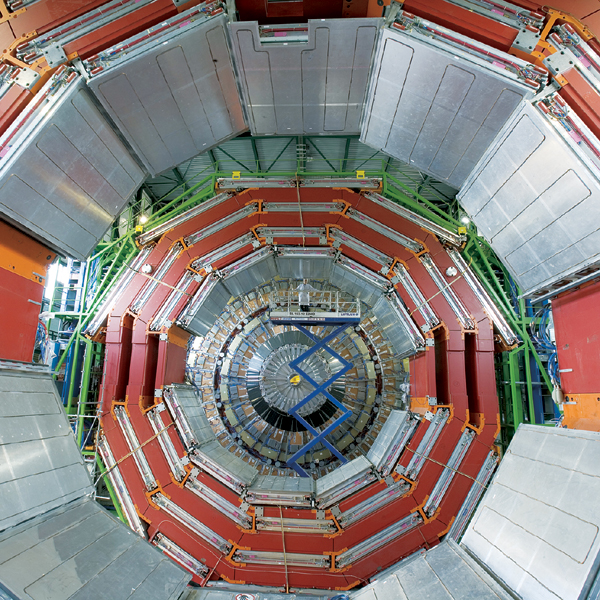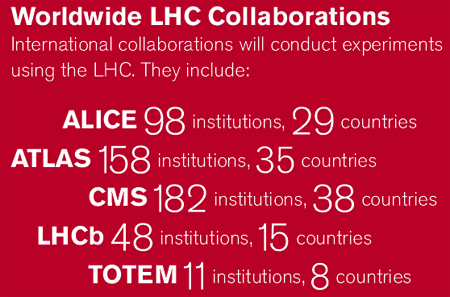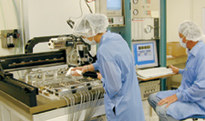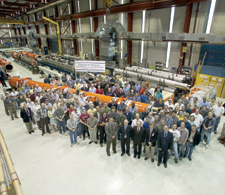The United States and the LHC
by Kurt Riesselmann
The United States has contributed the energy and expertise of hundreds of scientists and engineers, and more than half a billion dollars to the construction of the LHC particle collider and two of its experiments at the European laboratory CERN. Together with researchers from around the world, US scientists are looking forward to a decade of discovery.
 |
| The giant CMS detector takes shape at CERN. The US CMS collaboration designed the $44-million hadron calorimeter, which will measure the energy of particles produced in collisions at the center of the detector. |
| Photo: Fred Ullrich, Fermilab |
The construction of the Large Hadron Collider in Europe ranks with the largest scientific projects ever undertaken. When complete, the 27-kilometer ring-shaped particle collider will delve deep into the mysteries of the universe.
Scientists from the United States have played an integral role throughout the project.
"The United States is making important contributions to the LHC," says CERN's Emmanuel Tsesmelis, who is responsible for non-member-state relations. "The roughly 750 US researchers involved in the LHC are well-placed to participate in the exciting adventure of discovering the quantum universe."
Particle physics has a long history of international collaboration, and the LHC is another case in point.
"The US is a strong part of the LHC team," says Robin Staffin, Associate Director of Science for High Energy Physics at the US Department of Energy. "Our country has made important contributions to the design, development, and construction of the project, and we will help commission and operate the machine and its detectors. But within these international collaborations, nationalities lose meaning; national boundaries melt. Science is the great unifier. It brings countries together."
Global participation
More than 7000 scientists from 85-plus countries are involved in the LHC collider and its six experiments at the European laboratory CERN. They include some 750 scientists from US universities and national laboratories (see sidebar below). The US government has contributed $531 million to the development and construction of high-tech accelerator and detector components for the LHC, built by national laboratories, universities, and industry. Two federal agencies have shared the cost and administered the eight-year, soon-to-be-complete construction project: the Department of Energy ($450 million) and the National Science Foundation ($81 million).
"We are heavily into the final commissioning and installation phase of the ATLAS detector," says US ATLAS program manager Michael Tuts, of Columbia University. "Many of the ATLAS detector systems have US contributions, and right now there is quite a big presence of US physicists, technicians, and engineers at CERN. Some commute, some live there. I'm guessing that we [ATLAS] have of the order of 50 to 100 people living there."
The ATLAS and CMS detectors are among the largest scientific instruments ever built. Each as large as a fivestory house, the detectors function as huge "particle cameras " that record the energy, charge, and tracks of particles emerging from the proton-proton collisions produced at the centers of these detectors. The United States has provided about $331 million in equipment for the ATLAS and CMS detectors, divided evenly between the two.
Tuts manages the US funds for the ATLAS research program, which is currently ramping up. In addition to federal research funding that goes directly to the particle physics groups at US universities, federal agencies provide about a total of about $60 million per year to support work on the ATLAS and CMS experiments. "We use this money to support three areas," explains Tuts: "Commissioning, maintenance, and operation of the detector; software and computing expenses; and R&D on detector upgrades to prepare for higher luminosity."
Working on foreign soil is nothing new for US particle physicists, who have contributed to experiments at laboratories in Germany, Switzerland, and Japan, among others. But this time around the situation is different.
"In the past, people contributing to experiments in Europe often lived in Europe," says CMS physicist Sarah Eno, of the University of Maryland. "But that is hard and won't be possible for everyone because of the large number of people involved in the LHC experiments. I guess we have about 200 US graduate students working on CMS. Most will not be able to spend several years at CERN. We are finding ways to do our research from abroad."
Benefits for home institutions
Enabling scientists to participate as much as possible in the LHC experiments from their home institutions has been a top priority in the planning of the LHC project. Dictated by the large number of participants as well as the immense computing power needed to store and process the vast amount of LHC data, scientists are building a computing grid across the world. Starting from CERN, the grid will distribute the LHC data to regional computing centers around the world and provide users with access to analysis tools and global computing power.
"The LHC experiments are adding value to the scientific infrastructure in the United States," says Marvin Goldberg, Division of Physics program director at NSF. "Faculty and students are bringing new tools to their universities such as grid computing that have applications in many other areas of research, too. We make it possible for graduate students to participate in the LHC from their local universities. We even bring local high school teachers into the research. Through education programs such as QuarkNet, high school students will have access to data that will be the basis of revolutionary discoveries."
Like all scientists contributing to the LHC experiments, US physicists are eager to participate in operating the experiment, improving the data acquisition systems, and monitoring the performance of all devices.
To give US scientists the best possible access to the CMS experiment as well as to the monitoring of the LHC accelerator, Fermilab is about to construct a remote operations center that will duplicate the hardware and software of the control rooms at CERN. The center will give scientists real-time access to the vital data of the CERN accelerator complex and the CMS detector.
Together with videoconference rooms and other infrastructure, the remote operations center is part of the Fermilab LHC Physics Center, a gathering place for LHC physicists west of the Atlantic Ocean. The US ATLAS collaboration offers similar centers, known as physics analysis support centers, at several institutions distributed across the United States.
"Particle physics always has been pushing the envelope on communication," says Eno. "That's why the World Wide Web [invented at CERN] was developed by the particle physics community. We've always had a tremendous need for communication."
 |
|
|
Engineer Dean White (right) and technician Kirsten Affolder operate a gantry robot at the University of California, Santa Barbara, to assemble silicon detector modules for the CMS detector. |
In May 2004, Fermilab celebrated the shipment of the first Fermilab-KEK focusing magnet to CERN. |
High-tech magnets from the US
To expose the mysteries of matter, space, and time, the LHC will produce hundreds of millions of collisions per second. The exact collision rate depends on the performance of special magnets that focus the particle beams into the centers of the large collider detectors. Collaborating with CERN and the Japanese laboratory KEK, three DOE national laboratories–Fermilab, Brookhaven, and Lawrence Berkeley–have developed and built nine sets of beamfocusing systems for the LHC, each 40 meters long.
"It's great to see international collaborators making a large contribution to the construction of an accelerator," says Fermilab's Jim Kerby, the project manager of the US LHC Accelerator Project. "It provided us the opportunity to push magnet technology, to learn, and to train the next generation of skilled people. You don't have an opportunity like this very often."
About one third of the US-built focusing magnets have already been installed in the LHC tunnel, and the rest will be in place by March. When the LHC turns on in 2007, the magnets will "squeeze" the width of the two proton beams to less than the diameter of a hair. They will focus the beams on the collision points at the center of the detectors, maximizing the number of head-on protonproton collisions.
Ongoing R&D
Although the start-up of the LHC is about a year away, accelerator experts are already exploring options of making the LHC even better. To maximize the number of collisions– and hence the scientific productivity of the LHC–physicists anticipate upgrades to various parts of the machine.
Scientists from Brookhaven, Fermilab, Lawrence Berkeley, and Stanford Linear Accelerator Center are members of the US LHC Accelerator Research Program (LARP), which receives approximately $10 million of funding per year. A key aspect of the program is to train the next generation of accelerator experts in the United States. Just as the work on previous accelerators laid the foundation for the LHC, the current efforts will set the stage for the next generation of colliders.
"The United States is looking to future projects at CERN and is already participating in the CLIC [advanced accelerator] R&D," says Tsesmelis. "The collaboration between US and European laboratories on the ILC [International Linear Collider] is also strong, opening up opportunities for the globalization of the project. All this bodes well for a continued and robust collaboration between CERN and the United States in the future."
For now, experimenters are focusing on the great discoveries at the LHC that have become the topic of numerous science stories in newspapers and magazines. In turn, the number of graduate students interested in a career in particle physics is going up.
"The buzz is out there," says Tuts. "At US universities, we have a large number of incoming students who say, 'I want to do LHC physics.' They are hearing that there will be tremendously exciting physics.
US Institutions Participating in LHC 88 institutions from across the United States participate in five LHC experiments, and four US national laboratories belong to the US LHC Accelerator Research Program (LARP).
They are listed below:
|
|
Click here to download the pdf version of this article.








